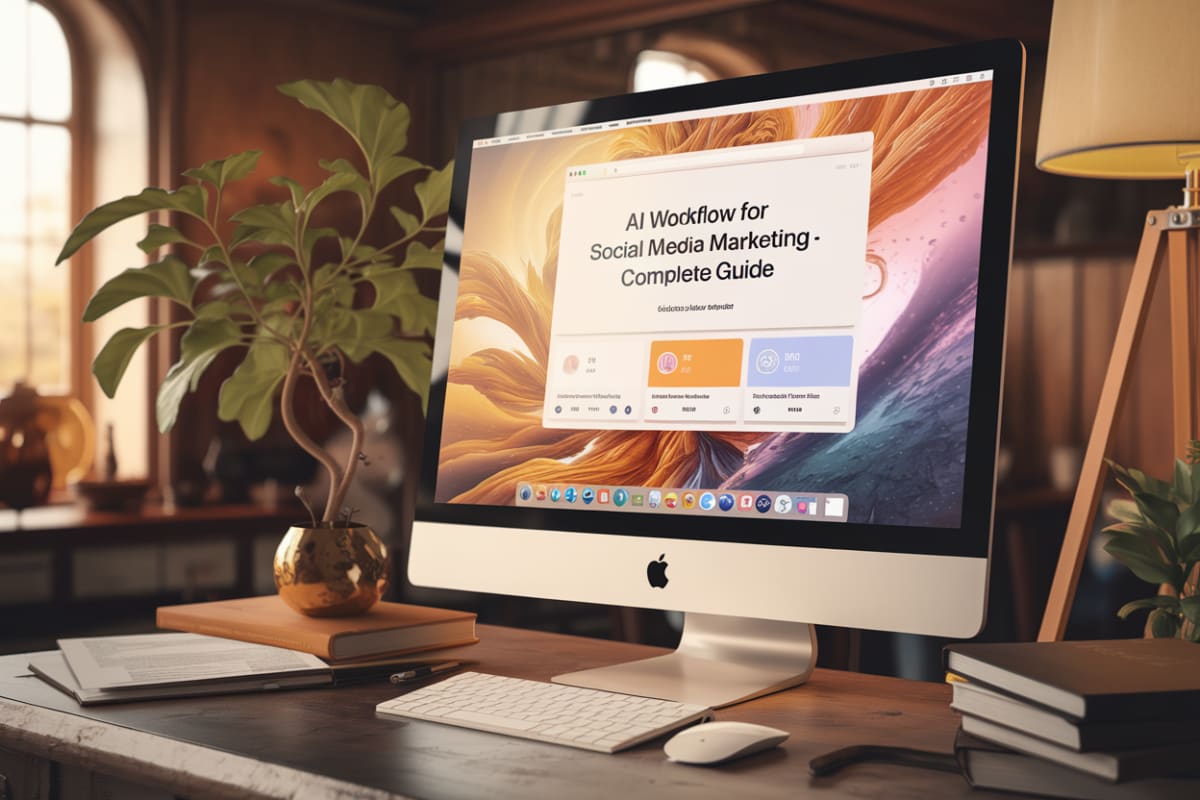Social Media Engagement: Complete Guide
What is Social Media Engagement?
Definition of Social Media Engagement
Social media engagement refers to the interaction between users and content on social media platforms. This includes actions such as likes, shares, comments, and direct messages. Engagement serves as a critical metric for measuring how effectively content resonates with an audience; it can indicate brand loyalty and customer satisfaction.
Examples of Engagement Metrics
- Likes: A simple metric indicating approval of a post. For instance, a Facebook post receiving 1,000 likes shows a strong positive reception.
- Comments: Comments indicate a deeper level of engagement, where users express their thoughts or ask questions. A brand post generating 500 comments can show a thriving conversation around the content.
- Shares: When users share a post, they extend its reach to their own network, effectively endorsing it. A tweet that gets retweeted 200 times can significantly amplify its visibility.
- Direct Messages (DMs): DMs represent private conversations between users and brands, often used for customer service inquiries. A brand receiving 70% of customer inquiries via DMs leverages this form of engagement effectively.
Case Studies
- Sprout Social's Holiday Shopping Survey: Their findings reveal that 89% of consumers report social media influences their holiday shopping decisions. Brands that engage users through compelling content inspire gift purchases, indicating that high engagement correlates with sales growth (Sprout Social).
- Hootsuite's Government Social Media Benchmarks: Their research shows that government agencies posting at optimal times (e.g., 7 AM on Thursday for Facebook) see higher engagement rates, averaging 4.2% on Instagram and 3.2% on Facebook. This illustrates how strategic engagement can enhance interaction metrics (Hootsuite).
Why is Social Media Engagement Important?
Influence on Consumer Behavior
Social media significantly impacts consumer purchasing decisions. A study shows that 89% of consumers state social media influences their holiday shopping, with platforms becoming essential for discovering gifts and deals (Sprout Social). About 42% of shoppers increasingly use social media for gift inspiration, especially among younger demographics like Gen Z, where 57% report using social media more for this purpose compared to previous years.
Brand Awareness and Loyalty
Social media engagement enhances brand awareness and fosters customer loyalty. Nearly half of social shoppers (49.5%) state that content from creators and influencers leads them to make purchases (eMarketer). Engaging consumers through social content can drive sales and build lasting brand relationships.
Customer Service Expectations
Engagement on social media reflects customer service trends. During peak shopping seasons, 92% of consumers intend to reach out to brands via social media for support, with 70% preferring direct messaging for privacy and immediacy (Sprout Social). Timely responses are expected, emphasizing the necessity for brands to engage effectively with their audience.
Emotional Engagement
Engagement is not just about numbers; it involves emotional connections. Research indicates that negative emotions like anger and fear drive higher engagement rates on social media. Content triggering strong emotional responses tends to be shared more, leading to increased visibility and interaction (Jeff Bullas).
Performance Metrics
Tracking social media engagement helps brands measure performance against industry benchmarks. For example, government agencies posting on Facebook see an engagement rate of around 3.2%, while financial institutions can achieve up to 5% on Instagram (Hootsuite). This data informs strategies for maximizing engagement and optimizing content.
Conclusion
In summary, social media engagement drives consumer behavior, enhances brand loyalty, meets customer service expectations, and measures performance through analytics. These factors collectively illustrate the importance of maintaining an active and engaging social media presence.
How Can I Improve My Social Media Engagement?
Strategies for Improving Social Media Engagement
Post High-Quality, Relevant Content
Consistently share high-quality, relevant content tailored to your audience's interests. Use high-resolution images, videos, and a mix of content formats such as Reels and Stories. For example, brands like National Geographic leverage stunning visuals combined with storytelling to engage their audience effectively.Utilize Hashtags Strategically
Use a combination of popular and niche hashtags to increase reach. A study shows posts with 10-15 well-chosen hashtags perform better than those overloaded with hashtags. Fashion brands often mix trending and niche-specific hashtags to connect with target audiences.Optimize Posting Times
Analyze when your audience is most active and schedule posts accordingly. Tools like Instagram Insights help identify peak times. Studies suggest posting on Instagram at 6 AM on Sundays and 8 AM on Wednesdays maximizes engagement.Create Interactive Content
Engage users with interactive Stories featuring polls, quizzes, and behind-the-scenes content. Brands like Starbucks utilize polls to gather customer opinions and preferences, fostering community engagement.Use Video Content and Reels
Leverage formats like Instagram Reels, which show increased visibility and engagement. Brands like Nike successfully use Reels to showcase products through dynamic storytelling, resulting in higher interaction rates.Encourage User Interaction
Prompt followers to like, comment, and share your posts. A simple call-to-action at the end of a video asking viewers to share their thoughts can significantly increase comment rates.Repurpose Evergreen Content
Repost top-performing content periodically to capture new audience members who may have missed it initially. For example, a viral post about financial tips could be shared again to reach a broader audience, as demonstrated by financial institutions that regularly repost successful educational content.Analyze and Adjust Strategies
Regularly review engagement metrics to understand what works and refine your approach accordingly. A brand may find that posts featuring customer testimonials generate higher engagement and can adjust their content strategy to incorporate more of this type of content.Collaborate with Influencers
Partner with influencers relevant to your niche to tap into their audience and enhance credibility. Beauty brands often collaborate with beauty influencers to reach a wider audience and boost product visibility.Foster Community Through Engagement
Respond to comments and messages to build a sense of community. Brands like Zappos are known for their exceptional customer service on social media, which fosters loyalty and encourages more interaction.Consider Automation Tools
Explore automation solutions like the AI Social Media Coordinator from Enrich Labs. This tool autonomously moderates and analyzes thousands of comments and DMs across platforms 24/7, ensuring a consistent brand voice and timely responses. It addresses the overwhelming volume of interactions while providing unique customer insights, allowing your team to focus on high-impact work.
By implementing these strategies, brands can enhance their social media engagement effectively and cultivate a loyal online community.
What Are the Best Practices for Social Media Engagement?
Best Practices for Social Media Engagement
Post High-Quality, Relevant Content
Consistently share content that resonates with your audience. This includes:- Understanding Your Audience: Tailor content based on what followers value, such as educational posts or behind-the-scenes looks.
- Using High-Resolution Media: Invest in good visuals; poor quality can deter engagement.
- Mixing Content Formats: Utilize various formats like Reels, carousels, and Stories to engage users differently.
Leverage Hashtags Strategically
- Use a Mix of Hashtags: Combine popular and niche hashtags to reach a broader audience while maintaining targeted engagement.
- Relevance and Moderation: Use hashtags that relate directly to your content and limit them to about 10-15 per post for clarity.
Optimize Posting Times
- Data-Driven Posting: Determine when your audience is most active using insights from platforms like Instagram. Posting on Instagram at 6 AM on Sundays could yield higher engagement rates.
Create Interactive Stories and Polls
Utilize Instagram Stories to engage directly with your audience through polls, quizzes, or behind-the-scenes content, encouraging interaction and feedback.Use Engaging Titles and Thumbnails
On platforms like YouTube, compelling titles and eye-catching thumbnails can significantly increase click-through rates, leading to more engagement.Encourage Audience Interaction
Prompt your audience to like, comment, and share your posts. Directly asking for engagement can lead to increased interaction rates.Regularly Analyze Engagement Metrics
Track metrics beyond likes and followers; focus on engagement rates, click-throughs, and conversion rates to assess the effectiveness of your strategies.
Case Studies and Examples
- Government Social Media Benchmarks: A study indicates that government agencies see optimal engagement on Facebook when posting at 7 AM on Thursdays and on Instagram at 6 AM on Sundays, suggesting timing's impact on engagement success (Hootsuite).
- Instagram Engagement Strategies: One report emphasizes the importance of interactive stories and polls, which drive significant engagement by encouraging followers to participate in real-time (Peter Karl).
- YouTube Content Quality: Another source highlights that consistent, high-quality content combined with strategic posting greatly enhances user engagement and loyalty on YouTube (Zeenews).
How Do Different Platforms Affect Social Media Engagement?
Engagement Rates by Platform
Different social media platforms exhibit varying engagement levels, influenced by factors such as content type, posting frequency, and audience behavior.
Engagement Rates Overview
Recent benchmarks show engagement rates across major platforms are as follows:
- Instagram: 4.2%
- Facebook: 3.2%
- X (Twitter): 2.4%
- LinkedIn: 2%
These figures indicate that Instagram generates the highest engagement, followed by Facebook, X, and LinkedIn, which has the lowest engagement rate among these platforms (Hootsuite).
Content Type and Engagement
The type of content shared on each platform significantly affects engagement:
- Facebook: Posts with albums generate the most engagement, followed by videos and links, suggesting users prefer interactive and visually rich content on Facebook (Hootsuite).
- Instagram: Users engage most with carousel posts, outperforming Reels and single-image posts in terms of interactions. This highlights the importance of format in driving engagement on Instagram (Buffer).
- LinkedIn: Engagement on LinkedIn is driven by posts containing images and videos, while text-only posts see less interaction, reflecting LinkedIn's professional nature where visual content resonates more (Hootsuite).
Posting Frequency
The frequency of posts plays a crucial role:
- X (Twitter): Government institutions achieve optimal engagement with just 1-2 posts per week, indicating that quality may trump quantity (Hootsuite).
- LinkedIn: Conversely, accounts posting more frequently (up to 10 times a week) see higher engagement, suggesting consistency and volume can be beneficial on this platform (Hootsuite).
Best Times to Post
Engagement can also be maximized by posting at optimal times:
- Facebook: Best engagement occurs around 7 AM on Thursdays.
- Instagram: Early mornings (6 AM on Sundays and 8 AM on Wednesdays) yield the highest engagement rates.
- X (Twitter): Engagement peaks on Thursday mornings (7-9 AM) (Hootsuite).
Conclusion
The differences in engagement levels across social media platforms underscore the importance of tailoring strategies based on platform-specific characteristics. Content type, posting frequency, and optimal posting times play integral roles in maximizing engagement on each platform.
What Metrics Should I Track for Social Media Engagement?
To effectively measure social media engagement, consider tracking the following key metrics:
Engagement Rate
This metric indicates how actively users interact with your content. As of September 2024, average engagement rates per platform are:- Instagram: 4.2%
- Facebook: 3.2%
- X (Twitter): 2.4%
- LinkedIn: 2%
This helps gauge the effectiveness of your posts in generating interactions compared to your audience size (Hootsuite).
Posting Frequency
The frequency with which you post can significantly impact engagement. Government institutions typically post more frequently on platforms like Facebook and X, with optimal posting frequencies varying:- Facebook: Average of 10 posts/week
- Instagram: Around 6 posts/week
- LinkedIn: 5 posts/week
Testing different frequencies is crucial to determine what works best for your audience (Hootsuite).
Content Type Performance
Different content types perform uniquely across platforms:- On Facebook, albums and videos generate the most engagement.
- On Instagram, carousels outperform regular photo posts and Reels in terms of engagement (Hootsuite).
Reach and Impressions
Understanding how many unique users view your content (reach) and how often it appears (impressions) is essential. Instagram Reels can offer 36% more reach compared to other post types, making them a powerful engagement tool (Buffer).Sentiment Analysis
Monitoring the sentiment of comments and interactions provides insights into how your audience feels about your brand. This qualitative data is essential for understanding brand perception and adjusting your strategy accordingly.Audience Insights
Analyzing demographics, preferences, and behaviors of your audience can inform content strategy. Tools like Hootsuite Analytics help you understand who engages with your content and how, allowing for more targeted efforts.Conversion Metrics
For businesses, tracking conversions from social media interactions (e.g., sign-ups, purchases) provides insights into the effectiveness of social media efforts in driving business goals (Hootsuite).
By focusing on these metrics, you can create a data-informed social media strategy that enhances engagement and meets your business objectives.
How Often Should I Post to Increase Engagement on Social Media?
Posting Frequency Recommendations
General Insights
The optimal posting frequency on social media varies significantly by platform and industry. Consider both the quality of content and specific audience engagement patterns.
For financial institutions, posting frequency can vary widely without significantly affecting engagement rates. Institutions posting frequently (up to 12 times a week) see similar engagement rates to those posting just once a week, indicating that content quality is more critical than quantity. However, an average of 7 posts per week is common among financial institutions (Hootsuite).
On Instagram, the sweet spot seems to be around 10 updates per week (including posts, Stories, and Reels) for financial services, as this frequency maximizes engagement. The best times for posting are generally between 7-11 AM on Tuesdays and Wednesdays, and 10 AM to noon on Fridays (Hootsuite).
For LinkedIn, engagement rates are notably high for profiles posting either once a week or up to 10 times a week. This flexibility allows institutions to tailor their frequency based on content availability and audience engagement (Hootsuite).
X (Formerly Twitter)
On X, a lower frequency of 1-2 posts per week is ideal for maintaining engagement, suggesting that less frequent, high-quality content may resonate better with followers (Hootsuite).
Testing and Analytics
Ultimately, the key to determining the best posting frequency lies in consistent testing and analyzing engagement metrics. Each organization should experiment with different frequencies to identify what works best for their specific audience and content type. Tools like Buffer assist in scheduling posts at optimal times while tracking performance across platforms (Buffer).
Conclusion
Social media engagement plays a vital role in shaping brand perception and driving consumer behavior. By implementing effective strategies and utilizing tools like the AI Social Media Coordinator from Enrich Labs, brands can enhance their engagement efforts, streamline interactions, and focus on growth.
Interested in transforming your social media management? Learn more about Enrich Labs' AI Social Media Coordinator and discover how it can help your team save time and boost productivity.




